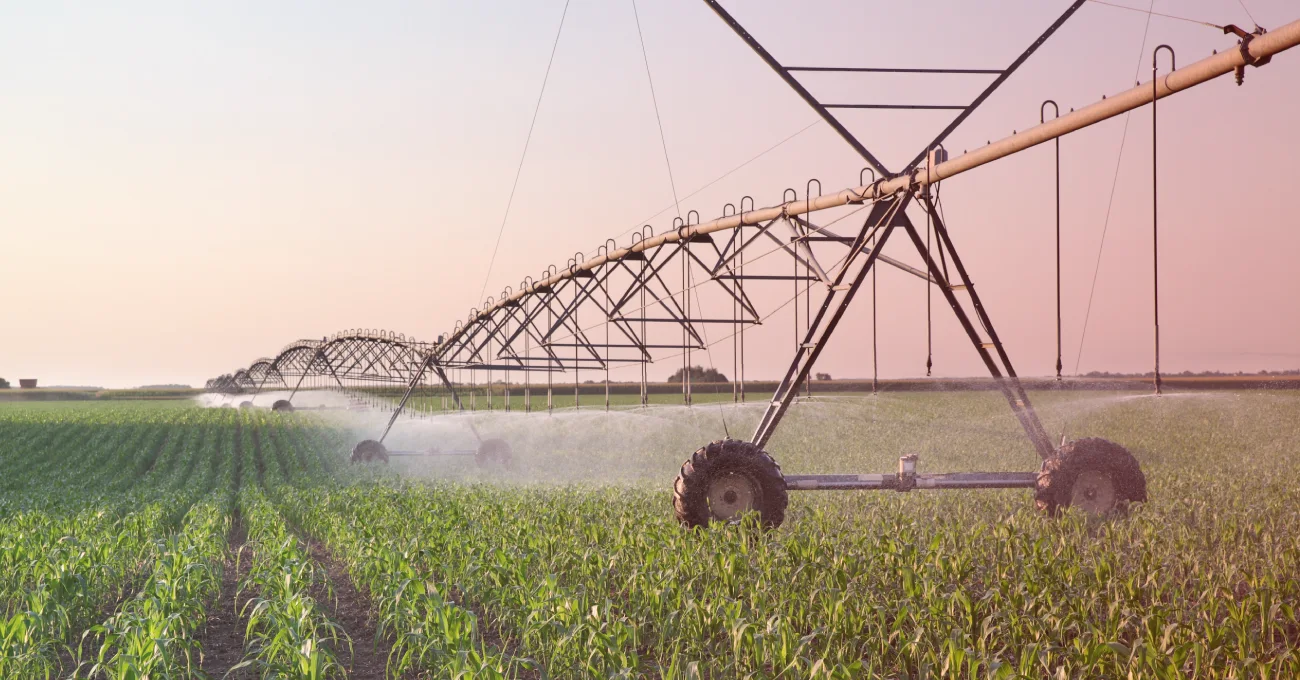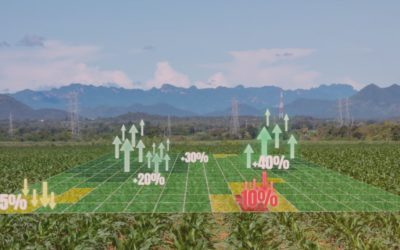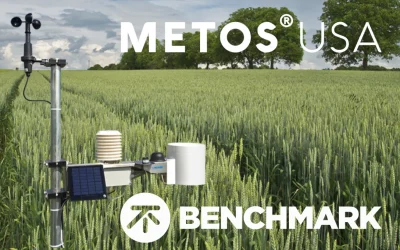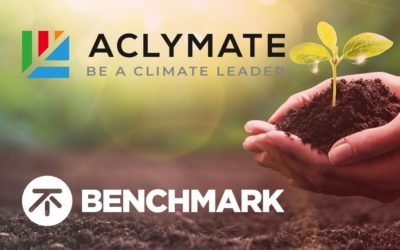Modern Methods to Measure Evapotranspiration in Commercial Agriculture
In many regions, abrupt changes to the climate have led to unexpected droughts and emphasized the importance of accurate measurement of evapotranspiration. These measurements inform decisions related to water resource management, wildfire prevention, the protection of endangered species, and agriculture.
In particular, accurate measurements of evapotranspiration are critical for effective irrigation management, as most land precipitation is returned into the atmosphere through this process. New methods for measuring evapotranspiration have enabled farmers to prevent overwatering and more effectively respond to drought.
What is evapotranspiration and why is it important?
Evapotranspiration is a combination of transpiration and evaporation, the processes by which water returns from the earth back into the atmosphere. Transpiration is the movement of water through plants and back into the air. Evaporation is the movement of water back into the air from soil and bodies of water.
Accurate measurements of evapotranspiration provide invaluable information for agricultural planning and irrigation systems. As average temperatures have increased in recent years, there have been more droughts and greater variability in the conditions of the environment. Dryer than expected conditions have led to forest fires, rising costs of water for livestock, and left farmers with insufficient irrigation for their crops. This has been particularly challenging for farms in California which are seeing new water regulations, volatile weather, and severe drought.
What are the methods of evapotranspiration measurement today?
There are multiple ways in which it can be measured right now. All of the existing methods have tradeoffs that need to be carefully considered.
• Field experiment
The most common ways involve using complex equations with significant room for measurement error. For example, you can estimate seasonal quantities of irrigation water by conducting a field experiment and using this equation:
Seasonal water requirement = Total irrigation water applied + Seasonal effective rainfall (Soil moisture at the beginning of the season – Soil moisture at the end of the season)
This kind of measurement is extremely limited and comes with the possibility for significant error. It can enable you to plan for your seasonal water needs, to some extent, but farmers utilizing this method are vulnerable to sudden changes in weather. Each season can be quite different and this limited information will not improve your ability to proactively address irrigation issues.
• Lysimeter
A lysimeter is a large container installed within a field that attempts to measure evapotranspiration. To track changes in moisture, you either weigh the lysimeter at set intervals, as the weight should change mostly as a function of the water in the lysimeter. Or you set up a system where the lysimeter is floating in water and track changes to the water level. The higher the moisture level, the more water will be displaced. If you use this method, you will need to ensure that the pool the lysimeter is floating in contains a consistent amount of water.
This method is more active than the field experiment. It will give you more actionable information but you need to ensure that you’re accurately controlling all variables. The conditions of the lysimeter need to match those of the rest of the field. To the extent that the conditions of your lysimeter differ from the crops on the other end of your plot, the measurements will be less accurate—irrigation, temperature, soil texture and density, and locations are all variables that need to be controlled.
• Atmometers
An atmometer is a device that uses a ceramic plate connected to a water supply by a straw to measure evapotranspiration. Water is pulled from the reservoir and wets the porous, ceramic plate. Water is continually drawn as the water on the plate evaporates. The cover of the plate is designed to prevent any material from entering the device and to simulate the experience of a plant in the field. Water cannot enter the atmometer but water vapor is able to escape. The color of the canvas cover should match the color of the plant and the device should be placed in direct sunlight, at a comparable height to the crop. As with the lysimeter, the more accurately the atmometer reflects the conditions of the plant, the better the measurement.
It’s easy to measure evapotranspiration with an atmometer. You just monitor the change in water level of the reservoir over a set timeframe. You can either operate your own, manual atmometer, or purchase an electronic version, like ETGage, which will automatically read and log the rate of evapotranspiration as the water evaporates from the plate. The biggest issues with atmometers is that weather can damage the device, ie. frost, and they require you to constantly refill the water supply.
• Water vapor analyzer and sonic anemometer
This instrument will calculate evapotranspiration by using the eddy covariance measurement. The water vapor analyzer measures the density of the water vapor in the air. The anemometer measures the wind’s speed and direction. These devices need to be able to measure at a high frequency, faster than 10 times per second, or there can be significant measurement errors. Like automated atmometers, these systems are sensitive to the conditions of your field and can be quite expensive. However, they provide actionable information about evapotranspiration and can be integrated with automated irrigation systems and other equipment.
How can machine learning improve evapotranspiration measurement?
If you install an automated evapotranspiration system, machine learning can automatically analyze your data to provide more actionable information. The latest systems can take in your data alongside historic and forecast data from the National Weather Service (NWS), the National Oceanic and Atmospheric Administration (NOAA), and other reliable sources to create predictive models. Machine learning enables these predictions to improve over time as the system compares its predictions to the real, measured value. Every time the model makes an inaccurate prediction, it will incorporate that data to improve future forecasts and provide more actionable information.
Artificial intelligence can reduce the number of sensors you need to create valuable, accurate forecasts. While there is variance in evapotranspiration throughout a farm, machine learning can allow us to more accurately extrapolate forecasts over larger areas, reducing the up-front cost for functional evapotranspiration measurement. Small on-farm weather stations add another layer of data to analyze alongside more generalized, gridded weather data.
Benchmark Labs aggregates NWS and NOAA data alongside the data recorded by localized farm sensors to create personalized forecasting for evapotranspiration and other important measures. Farmers who install on-farm weather stations, for every five to ten acres of land, and connect to our machine learning systems consistently deliver 60% more accurate 10-day forecasts. This helps them to proactively respond to potential frost, plan for the next season, and even complete an early harvest if need be.
Farmers receive the live data through their sensor system and the actionable insights our predictive models provide. The more data the system takes in and the more time it has to calibrate its predictions, the more actionable the information it provides will be. Every farm is different. More generalized models are inaccurate for the entire region, let alone the microclimate of a farm. Machine learning systems are valuable because they consistently improve over time and adapt to changes in the climate.
Water management matters
As the climate continues to change and droughts become a greater risk, better evapotranspiration measurement and localized weather modeling will enable farmers to protect their crops and improve the efficiency of their automated irrigation systems. This type of personalized information can make all the difference when deciding which crops to plant the next season and mitigating the downsides of drought.
Benchmark Labs is creating specialized machine learning models to create the world’s best evapotranspiration forecasting and localized 10-day forecasts. We are looking for more companies in agriculture to help us pioneer this technology and create an agricultural sector that is resilient to future shocks and water challenges.
—
If you would like to learn more about Benchmark Labs from our team and sign up for a trial, go to our sign-up page.
Recent Posts
Sub-Acre Weather Forecasting Is The Future For Agriculture
[dssb_sharing_button icon_bg="#636979" _builder_version="4.16" _module_preset="default" background_color="#324155"...
Metos USA Becomes A Benchmark Labs Preferred Hardware Provider
CALIFORNIA – 19 January 2022 – Benchmark Labs Inc. (Benchmark Labs), a leading provider of asset-specific environmental forecasting solutions and Metos USA by Pessl Instruments, a leading provider of IoT-driven weather sensors are excited to announce an integration...
Aclymate Certifies Benchmark Labs As A Climate Leader
COLORADO – 15 January 2022 – Benchmark Labs Inc. (Benchmark Labs), a leading provider of asset-specific environmental forecasting solutions becomes certified as a Climate Leader by Aclymate a provider of small business climate solutions. This certification means...




